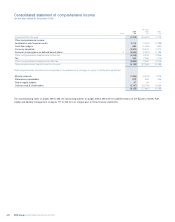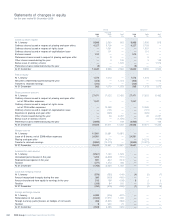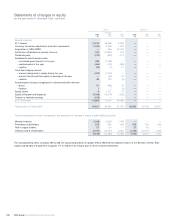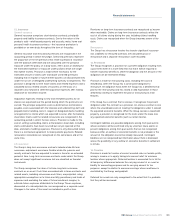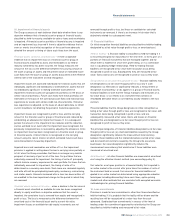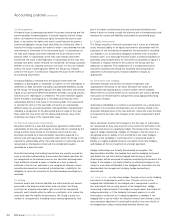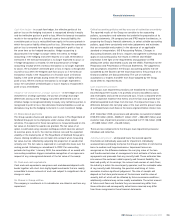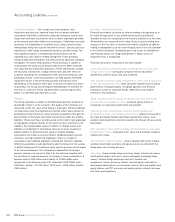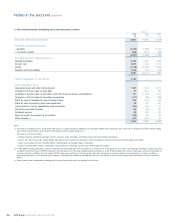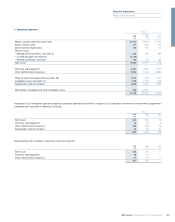RBS 2009 Annual Report Download - page 254
Download and view the complete annual report
Please find page 254 of the 2009 RBS annual report below. You can navigate through the pages in the report by either clicking on the pages listed below, or by using the keyword search tool below to find specific information within the annual report.RBS Group Annual Report and Accounts 2009252
15. Financial assets
On initial recognition, financial assets are classified into held-to-maturity
investments; available-for-sale financial assets; held-for-trading;
designated as at fair value through profit or loss; or loans and
receivables.
Held-to-maturity investments – a financial asset may be classified as a
held-to-maturity investment only if it has fixed or determinable payments,
a fixed maturity and the Group has the positive intention and ability to
hold to maturity. Held-to-maturity investments are initially recognised at
fair value plus directly related transaction costs. They are subsequently
measured at amortised cost using the effective interest method (see
accounting policy 3) less any impairment losses.
Held-for-trading – a financial asset is classified as held-for-trading if it is
acquired principally for sale in the near term, or forms part of a portfolio
of financial instruments that are managed together and for which there
is evidence of short-term profit taking, or it is a derivative (not in a
qualifying hedge relationship). Held-for-trading financial assets are
recognised at fair value with transaction costs being recognised in profit
or loss. Subsequently they are measured at fair value. Gains and losses
on held-for-trading financial assets are recognised in profit or loss as
they arise.
Designated as at fair value through profit or loss – financial assets may
be designated as at fair value through profit or loss only if such
designation (a) eliminates or significantly reduces a measurement or
recognition inconsistency; or (b) applies to a group of financial assets,
financial liabilities or both, that the Group manages and evaluates on a
fair value basis; or (c) relates to an instrument that contains an
embedded derivative which is not evidently closely related to the host
contract.
Financial assets that the Group designates on initial recognition as
being at fair value through profit or loss are recognised at fair value, with
transaction costs being recognised in profit or loss, and are
subsequently measured at fair value. Gains and losses on financial
assets that are designated as at fair value through profit or loss are
recognised in profit or loss as they arise.
The principal category of financial assets designated as at fair value
through profit or loss is policyholders’ assets underpinning insurance
and investment contracts issued by the Group's life assurance
businesses. Fair value designation significantly reduces the
measurement inconsistency that would arise if these assets were
classified as available-for-sale.
Loans and receivables – non-derivative financial assets with fixed or
determinable repayments that are not quoted in an active market are
classified as loans and receivables, except those that are classified as
available-for-sale or as held-for-trading, or designated as at fair value
through profit or loss. Loans and receivables are initially recognised at
fair value plus directly related transaction costs. They are subsequently
measured at amortised cost using the effective interest method (see
accounting policy 3) less any impairment losses.
Available-for-sale – financial assets that are not classified as held-to-
maturity; held-for-trading; designated as at fair value through profit or
loss; or loans and receivables, are classified as available-for-sale.
Financial assets can be designated as available-for-sale on initial
recognition. Available-for-sale financial assets are initially recognised at
fair value plus directly related transaction costs. They are subsequently
measured at fair value. Unquoted equity investments whose fair value
cannot be measured reliably are carried at cost and classified as
available-for-sale financial assets. Impairment losses and exchange
differences resulting from retranslating the amortised cost of foreign
currency monetary available-for-sale financial assets are recognised in
profit or loss together with interest calculated using the effective interest
method (see accounting policy 3). Other changes in the fair value of
available-for-sale financial assets are reported in a separate component
of shareholders’ equity until disposal, when the cumulative gain or loss
is recognised in profit or loss.
Reclassifications – held-for-trading and available-for-sale financial assets
that meet the definition of loans and receivables (non-derivative financial
assets with fixed or determinable payments that are not quoted in an
active market) may be reclassified to loans and receivables if the Group
has the intention and ability to hold the financial asset for the
foreseeable future or until maturity. The Group typically regards the
foreseeable future as twelve months from the date of reclassification.
Additionally, held-for-trading financial assets that do not meet the
definition of loans and receivables may, in rare circumstances, be
transferred to available-for-sale financial assets or to held-to-maturity
investments. Reclassifications are made at fair value. This fair value
becomes the asset’s new cost or amortised cost as appropriate. Gains
and losses recognised up to the date of reclassification are not
reversed.
Regular way purchases of financial assets classified as loans and
receivables are recognised on settlement date; issues of equity or
financial liabilities measured at amortised cost are recognised on
settlement date; all other regular way transactions in financial
instruments are recognised on trade date.
Fair value for a net open position in a financial asset that is quoted in an
active market is the current bid price times the number of units of the
instrument held. Fair values for financial assets not quoted in an active
market are determined using appropriate valuation techniques including
discounting future cash flows, option pricing models and other methods
that are consistent with accepted economic methodologies for pricing
financial assets.
Accounting policies continued


